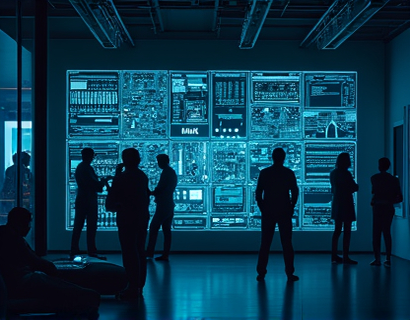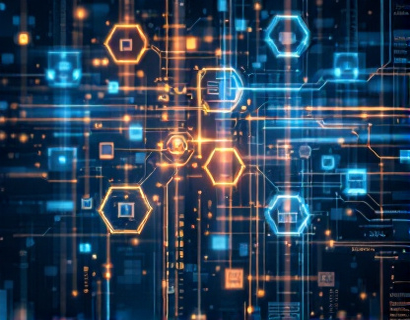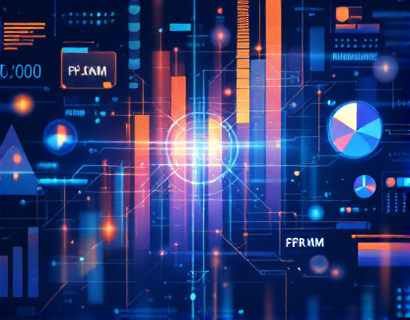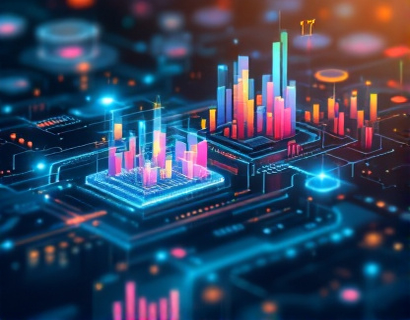Unlocking Digital Transformation: Leveraging Crypto and AI for Enhanced User Experiences
The digital landscape is undergoing a profound transformation, driven by the convergence of cryptocurrency and artificial intelligence. This synergy is not just a technological curiosity but a powerful force reshaping how we interact with digital platforms. As we delve into this topic, it's essential to understand the fundamental components of blockchain technology and machine learning, and how their integration is redefining user experiences across various sectors.
Understanding Blockchain Technology
Blockchain, at its core, is a decentralized ledger technology that ensures transparency, security, and immutability. Each transaction is recorded in a block, which is then linked to the previous block, forming a chain. This structure eliminates the need for intermediaries, reducing costs and increasing efficiency. The decentralized nature of blockchain means that no single entity controls the network, making it resilient to censorship and fraud.
One of the most significant advantages of blockchain is its ability to provide a trustless environment. Users can transact with each other without needing to trust a central authority. This is achieved through cryptographic algorithms that secure transactions and verify the authenticity of data. The transparency of blockchain ensures that all participants have access to the same information, fostering trust and accountability.
The Role of Artificial Intelligence
Artificial intelligence, on the other hand, refers to the simulation of human intelligence processes by machines, particularly computer systems. These processes include learning, reasoning, and self-correction. AI technologies such as machine learning, natural language processing, and computer vision enable machines to perform tasks that traditionally required human intervention.
Machine learning, a subset of AI, focuses on building systems that can learn from and make predictions based on data. This capability allows AI to improve its performance over time without being explicitly programmed. Natural language processing (NLP) enables machines to understand and generate human language, making interactions more natural and intuitive. Computer vision allows machines to interpret and make decisions based on visual data, enhancing applications in areas like image recognition and autonomous systems.
Synergy Between Crypto and AI
The combination of blockchain and AI creates a powerful toolkit for enhancing digital experiences. By leveraging the security and transparency of blockchain, AI systems can operate in a trustworthy and secure environment. This synergy opens up new possibilities for applications that require high levels of data integrity and user trust.
One of the key areas where crypto and AI intersect is in data management. Blockchain can provide a secure and decentralized way to store and manage data, ensuring that AI systems have access to reliable and tamper-proof information. This is particularly important in industries like healthcare, finance, and supply chain management, where data accuracy and security are paramount.
Enhanced Data Privacy and Security
Data privacy is a growing concern in the digital age. Blockchain's decentralized and encrypted nature offers a robust solution to protect user data. By storing data on a blockchain, users can maintain control over their information and decide who has access to it. AI can complement this by implementing advanced encryption techniques and anomaly detection to further secure data against breaches and unauthorized access.
For instance, in the realm of identity verification, blockchain can create a decentralized identity system where users own and manage their digital identities. AI can enhance this system by using biometric data and behavioral patterns to authenticate users, reducing the risk of identity theft and fraud.
Optimized User Interactions
AI-driven personalization is another area where the integration of crypto and AI shines. By analyzing user behavior and preferences, AI can deliver tailored experiences that enhance user engagement and satisfaction. Blockchain ensures that this data is handled securely and transparently, giving users more control over their information.
Consider a digital content platform that uses AI to recommend articles or videos based on a user's viewing history. By storing user preferences and interaction data on a blockchain, the platform can ensure that this information is not tampered with and that users have full transparency over how their data is used. This not only improves the accuracy of recommendations but also builds trust with users.
Use Cases in Various Industries
The potential applications of blockchain and AI are vast and varied, spanning multiple industries. Let's explore some specific use cases to illustrate the transformative impact of this technology combination.
Finance and Banking
In the finance sector, the integration of blockchain and AI can revolutionize processes such as fraud detection, risk management, and customer service. AI algorithms can analyze transaction patterns in real-time, identifying suspicious activities and flagging potential fraud cases. Blockchain ensures that all transactions are recorded immutably, providing a clear audit trail.
Smart contracts, self-executing contracts with the terms directly written into code, can automate and enforce agreements between parties. AI can optimize the execution of these contracts by predicting outcomes and adjusting parameters based on market conditions. This not only speeds up processes but also reduces the need for intermediaries, lowering costs and increasing efficiency.
Healthcare
In healthcare, the combination of blockchain and AI can lead to more accurate diagnoses, personalized treatments, and secure patient data management. AI can analyze vast amounts of medical data to identify patterns and predict disease outcomes, while blockchain ensures that patient data is stored securely and can be shared seamlessly between healthcare providers.
Electronic health records (EHRs) stored on a blockchain can be accessed by authorized parties with the patient's consent, ensuring data integrity and privacy. AI-powered diagnostic tools can analyze medical images and patient data to assist doctors in making more informed decisions. This not only improves patient care but also enhances the overall efficiency of healthcare systems.
Supply Chain Management
Supply chain management is another area where blockchain and AI can drive significant improvements. Blockchain provides a transparent and immutable record of every step in the supply chain, from production to delivery. AI can optimize logistics by predicting demand, managing inventory, and identifying bottlenecks in the supply chain.
For example, a company can use AI to analyze historical sales data and weather patterns to predict future demand for a product. Blockchain ensures that all transactions and movements of goods are recorded accurately, reducing the risk of fraud and errors. This level of transparency and efficiency can lead to cost savings and improved customer satisfaction.
Challenges and Considerations
While the potential benefits of integrating blockchain and AI are substantial, there are also challenges and considerations that need to be addressed. One of the primary challenges is the technical complexity of implementing these technologies. Both blockchain and AI require specialized knowledge and expertise, which can be a barrier for smaller organizations.
Another consideration is the regulatory landscape. As these technologies are relatively new, regulations are still evolving. Companies must navigate a complex web of laws and standards to ensure compliance. Additionally, there are concerns about the environmental impact of blockchain, particularly proof-of-work systems, which consume significant amounts of energy.
Scalability and Interoperability
Scalability is a critical issue for blockchain technology. As the number of transactions increases, the network can become slow and expensive to use. However, advancements in blockchain design, such as layer 2 solutions and sharding, are addressing these scalability concerns. Interoperability between different blockchain platforms is also essential for creating a seamless user experience.
AI, on the other hand, faces challenges related to data quality and bias. The accuracy of AI models depends on the data they are trained on, and biased data can lead to unfair or inaccurate outcomes. Ensuring diverse and representative datasets is crucial for developing fair and reliable AI systems.
Future Outlook
The future of digital interactions is increasingly shaped by the synergy of blockchain and AI. As these technologies continue to evolve, we can expect to see more innovative applications and broader adoption across various industries. The key to unlocking this potential lies in fostering collaboration between technologists, policymakers, and industry leaders to address the challenges and harness the full benefits of this technological revolution.
Early adopters and tech enthusiasts who embrace these technologies now will be well-positioned to capitalize on the opportunities they present. By staying informed and proactive, they can drive growth and innovation in the digital landscape.










































